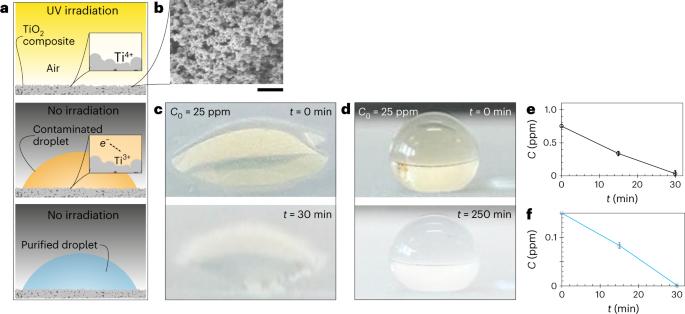Photocatalytically reactive surfaces for simultaneous water harvesting and treatment
IF 25.7
1区 环境科学与生态学
Q1 ENVIRONMENTAL SCIENCES
引用次数: 1
Abstract
Atmospheric water harvesting provides decentralized and sustainable supplies of fresh water in areas away from natural water resources. However, an important challenge is that water sources such as fog are subject to contamination from airborne pollutants, especially near population centres. Here we demonstrate a rationally designed system that can capture fog at high efficiency while simultaneously degrading organic pollutants. At the heart of our design is a wire mesh coated with anatase titanium dioxide nanoparticles embedded in a polymer matrix. Once activated by sunlight, the photoactive titanium dioxide layer decomposes organic molecules such as diesel, even in the absence of sunlight; moreover, the wettability of the mesh surface is engineered to enhance water extraction. In outdoor tests, the device can maintain a good fog harvesting performance as well as a water treatment efficiency of >85%. The continuous production of water with passive purification demonstrated in our study provides an energy-free solution to address water scarcity. Atmospheric water harvesting is challenging due to the presence of airborne pollutants. The authors show a device design that enables fog capture with simultaneous pollutant decomposition powered by sunlight.

用于同时集水和处理的光催化反应表面
大气集水为远离天然水资源的地区提供了分散和可持续的淡水供应。然而,一个重要的挑战是,雾等水源会受到空气中污染物的污染,尤其是在人口中心附近。在这里,我们展示了一种设计合理的系统,它能高效捕捉雾气,同时降解有机污染物。我们的设计核心是在聚合物基质中嵌入一个涂有锐钛矿二氧化钛纳米颗粒的金属丝网。一旦被阳光激活,光活性二氧化钛层就会分解柴油等有机分子,即使在没有阳光的情况下也是如此;此外,我们还设计了网眼表面的润湿性,以提高水的提取率。在室外测试中,该装置能保持良好的雾收集性能,水处理效率高达 85%。我们在研究中展示的连续生产水和被动净化为解决水资源短缺问题提供了一种无能源解决方案。由于空气中污染物的存在,大气采水具有挑战性。作者展示了一种设备设计,它能在捕获雾气的同时利用阳光分解污染物。
本文章由计算机程序翻译,如有差异,请以英文原文为准。
求助全文
约1分钟内获得全文
求助全文
来源期刊

Nature Sustainability
Energy-Renewable Energy, Sustainability and the Environment
CiteScore
41.90
自引率
1.10%
发文量
159
期刊介绍:
Nature Sustainability aims to facilitate cross-disciplinary dialogues and bring together research fields that contribute to understanding how we organize our lives in a finite world and the impacts of our actions.
Nature Sustainability will not only publish fundamental research but also significant investigations into policies and solutions for ensuring human well-being now and in the future.Its ultimate goal is to address the greatest challenges of our time.
 求助内容:
求助内容: 应助结果提醒方式:
应助结果提醒方式:


